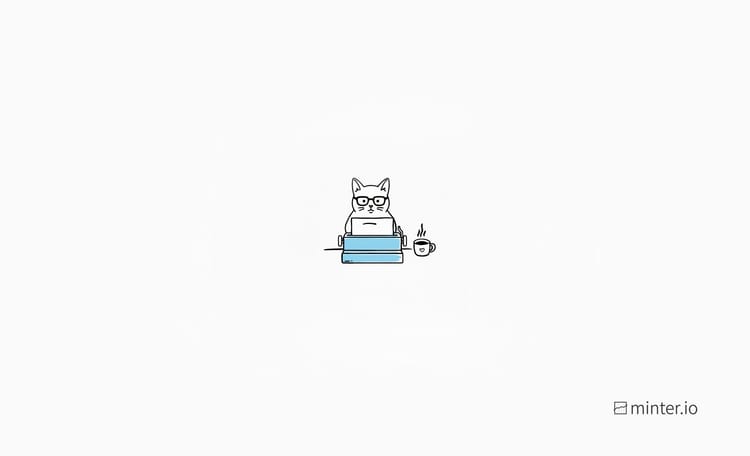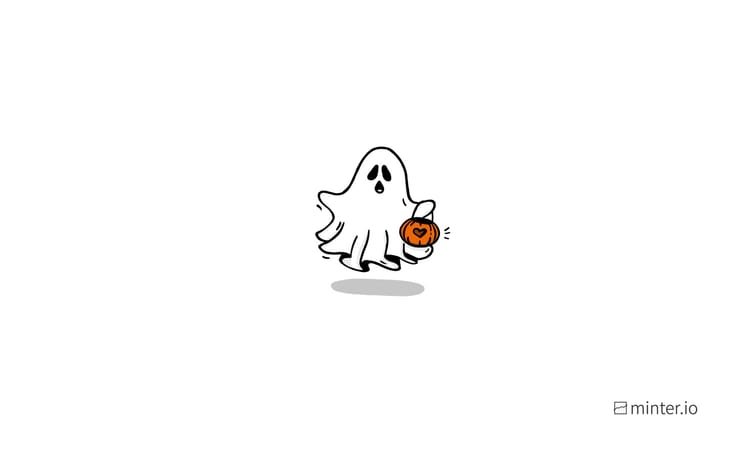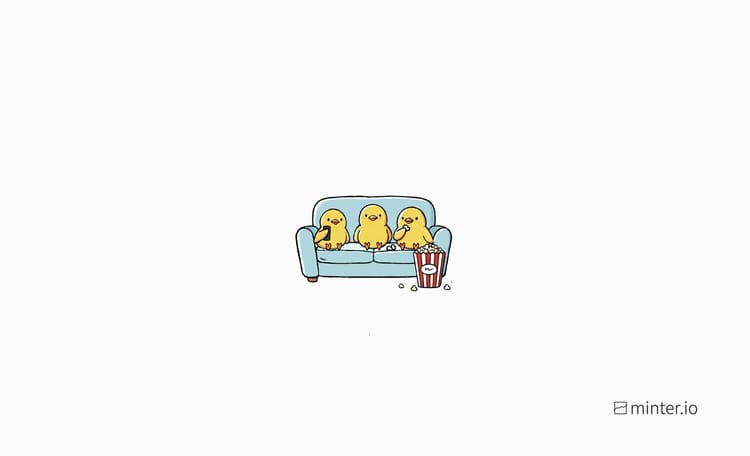How Duolingo’s latest marketing campaign stole the world’s attention
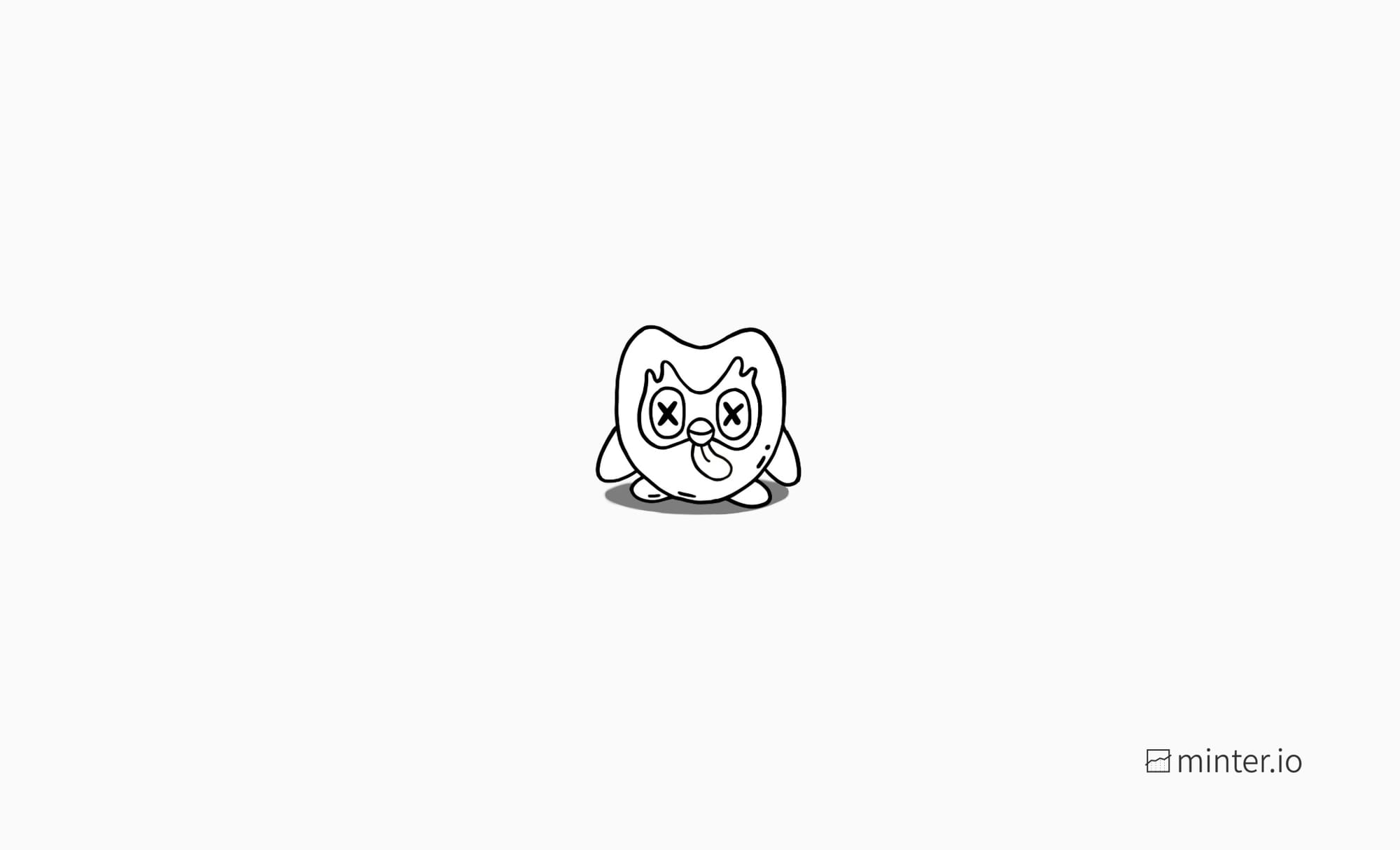
Duolingo recently pulled off the most inventive, unhinged social media marketing campaign of the year so far and it got the world talking its language. In a string of dramatic posts, Duolingo killed off its mascot, sparking commentary from news channels, major brands and famous faces. The hilarious, hyperbolic campaign was a huge success which featured multiple viral posts and skyrocketed Duolingo’s combined social media following to over 25 million.
In this article, we’re going to cast a magnifying glass over Duolingo’s latest campaign to dissect the elements that made it successful, and pull out the main features for you to analyse for your own marketing efforts.
The Duolingo ‘Duo is dead’ campaign
On February 11th 2025, social media users around the globe were hit with the announcement that Duolingo’s mascot, Duo, was dead. The language learning app followed up this humorous announcement with a series of posts investigating the cause of death and additionally killing off Duo’s friends, before making a grand revival of Duo to round off the campaign.
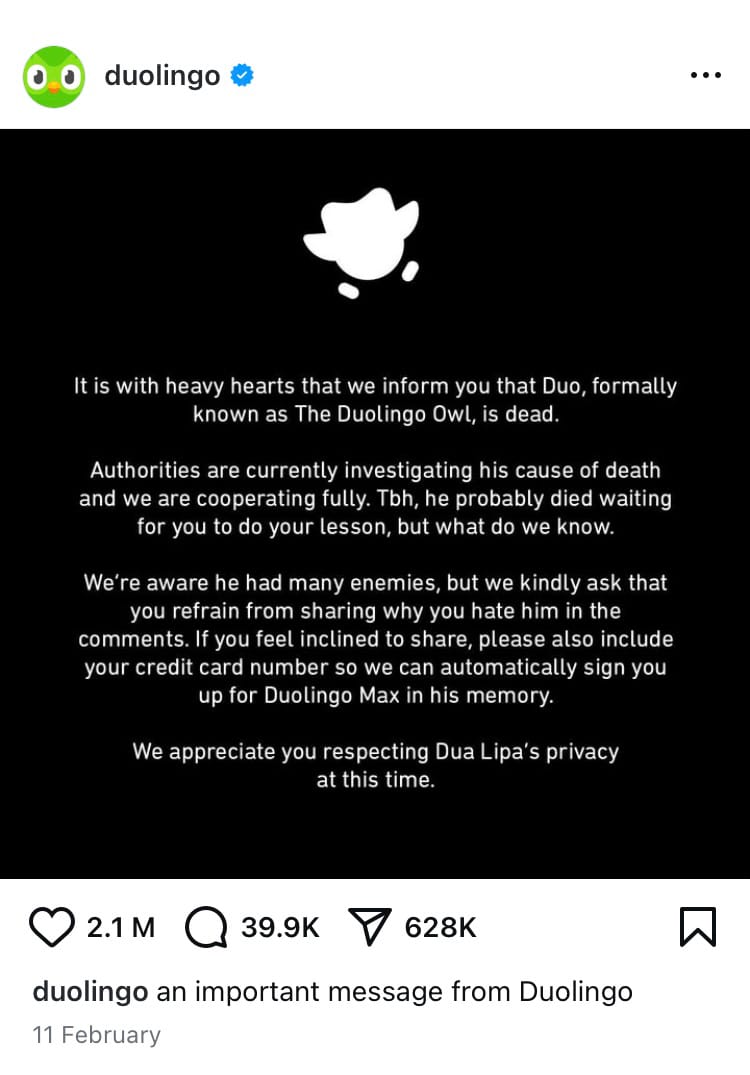
As a result of this marketing campaign, Duolingo gained a huge spike of new followers across its social media accounts. Using the competitor feature on Minter.io we can see a distinctive spike in followers across multiple social media profiles owned by Duolingo. On Instagram alone, on the day of the initial post Duolingo saw a spike of over 100 thousand more followers than usual, and these followers haven’t dropped off since the campaign’s conclusion. This truly is a triumph for the brand and its social media marketing team.
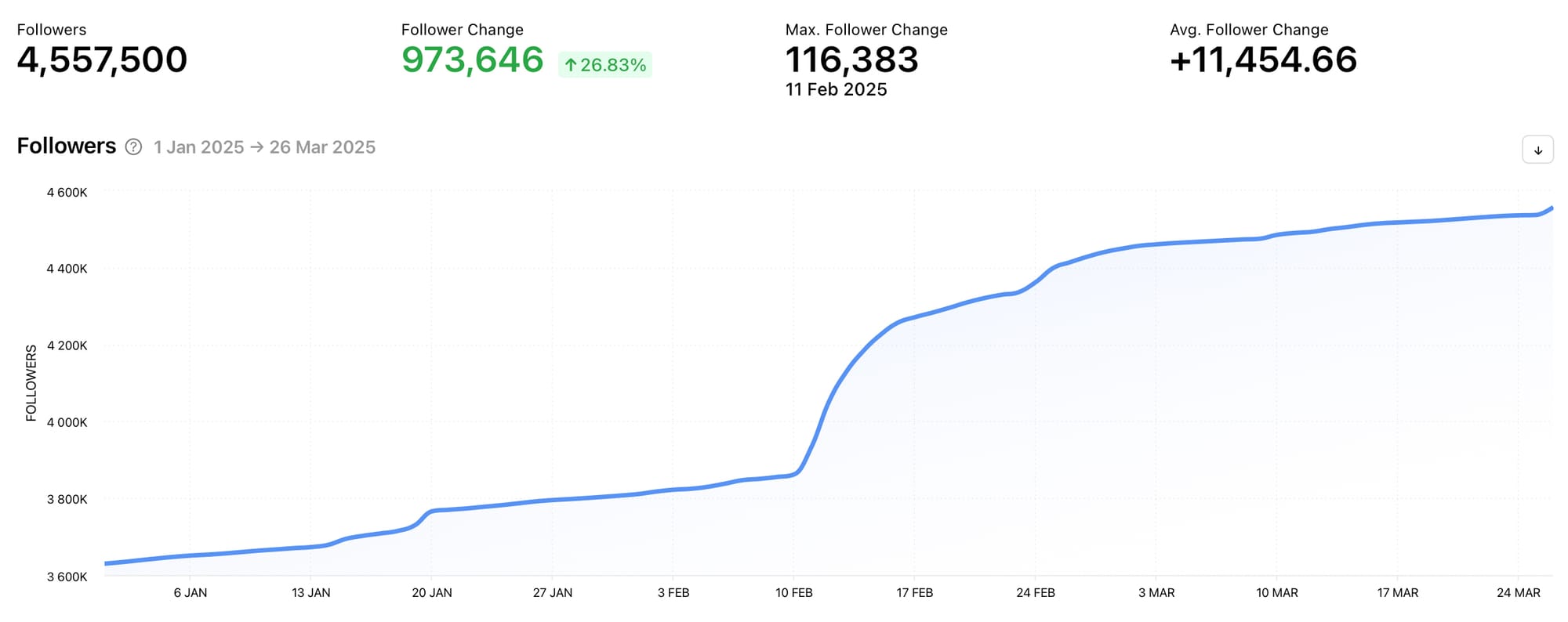
Why Duolingo’s marketing campaign worked
Duolingo’s in-house social media marketing team has a hands-on approach and a very fast turn around. If this marketing campaign wasn’t already impressive enough, the fact that the campaign went from concept to execution in just six days makes it even more remarkable.
Alongside Duolingo’s keen insight into its audience and the types of content its followers relate to, there were a number of things that made this specific marketing campaign so successful. The hyperbolic idea grabbed attention, the execution was impeccably humorous and there was a beautiful balance between storyline and product promotion.
Here are 3 techniques that made it a winning campaign…
1. The power of the mascot
Brand mascots are no new thing, but in the age of the internet when user-generated content, memes and GIFs take social commentary to extraordinary heights, mascots take on a life of their own. One thing’s for sure, Duolingo’s mascot Duo wouldn’t be the high-flying bird of its day without fans of the brand memeing it into oblivion.
While the Duolingo owl has been around since 2011, and has had several makeovers since, it wasn’t until 2017 that it became an internet sensation. Duo was responsible for reminding users to do their lessons, and its persistent nature soon caused a stir in the Duolingo community. The notifications featuring Duo were heavily memed online, turning this cute little mascot into a passive-aggressive, somewhat violent menace by the hyperbolic creations of internet users. The growing amount of memes increased the popularity of Duolingo and shot Duo into superstardom, making it a no-brainer to plaster the owl all over the Duolingo social media accounts and branding.


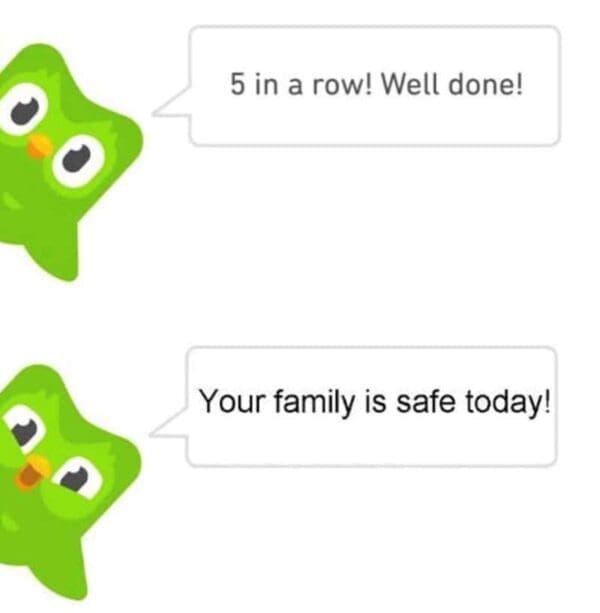
Memes inspired by Duolingo’s mascot Duo
With the kind of lore and popularity that Duo has, it makes the mascot’s use a sure-fire win for the kind of campaign Duolingo crafted. People love chatting about Duo on the internet and many users have a love-hate relationship with the mascot, making its death a colossal conversation starter.
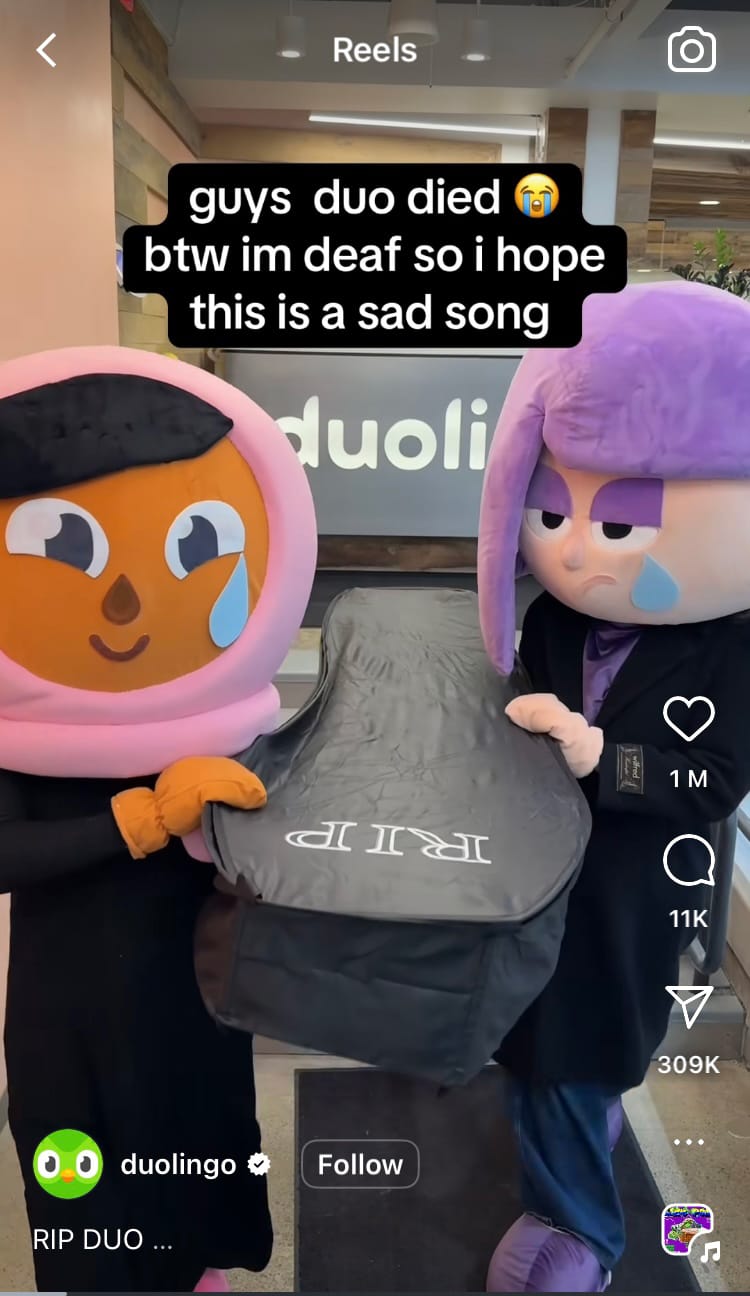
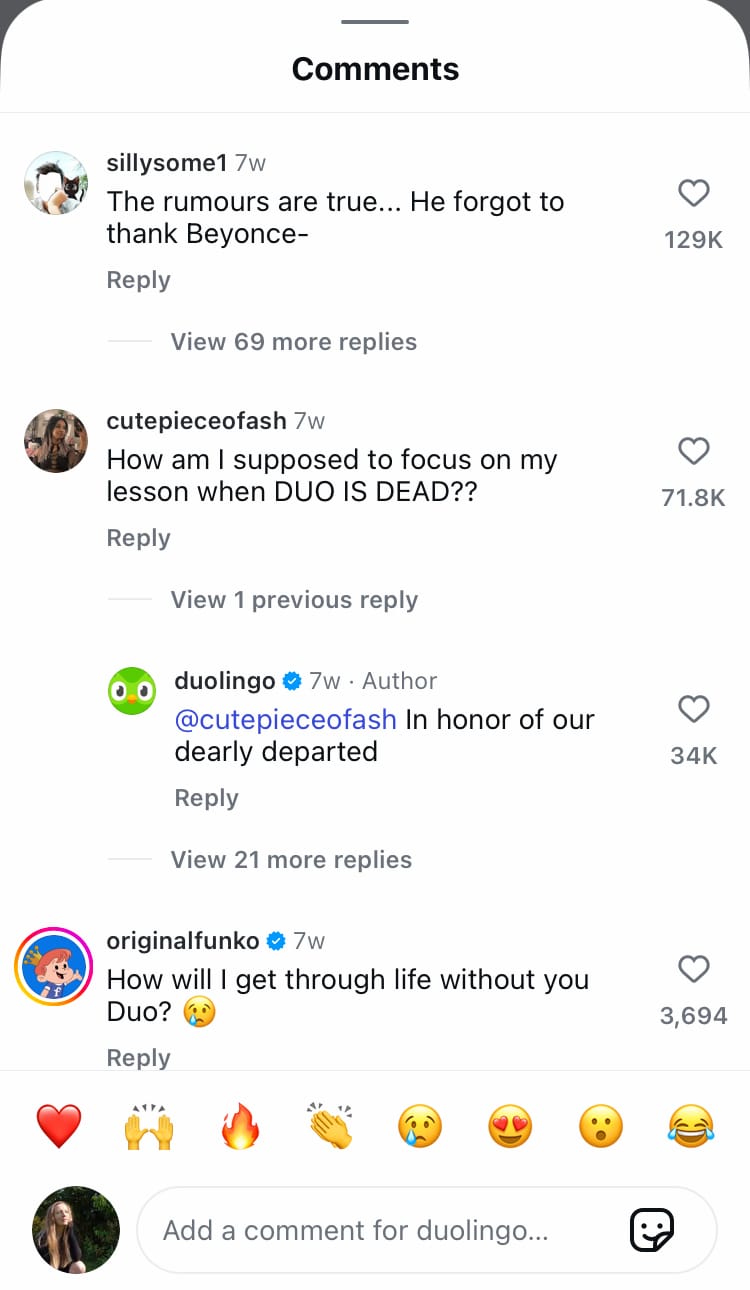
Instagram reel by Duolingo and comments by fans of the brand
Duolingo proves that great marketing doesn’t have to hammer home what your business is about. The truth is, it’s far more enjoyable to watch the antics of an unhinged mascot than be hit over the head with the ins and outs of a product or service. When the moment comes to learn a language, Duolingo is at the forefront of many people’s minds, not because they know everything about the app, but because they’ve been exposed to the brand and remembered it.
2. Leveraging social commentary
One huge element that elevated the success of the Duolingo campaign was the social commentary that was fuelled by other monumental brands and businesses. The comments sections on multiple high-performing pieces of content in the campaign were littered with verification check marks. Recognisable brands and businesses made witty jokes and humorous remarks and even partook in trendjacking.
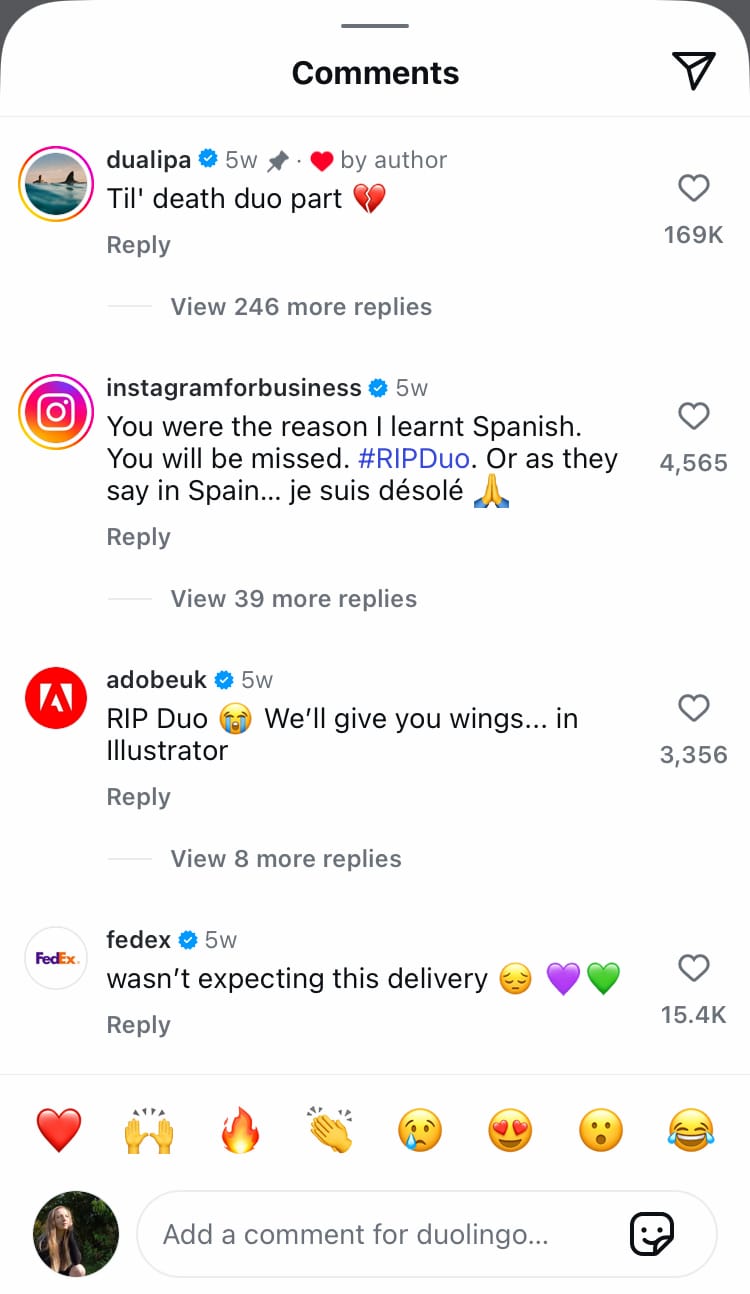
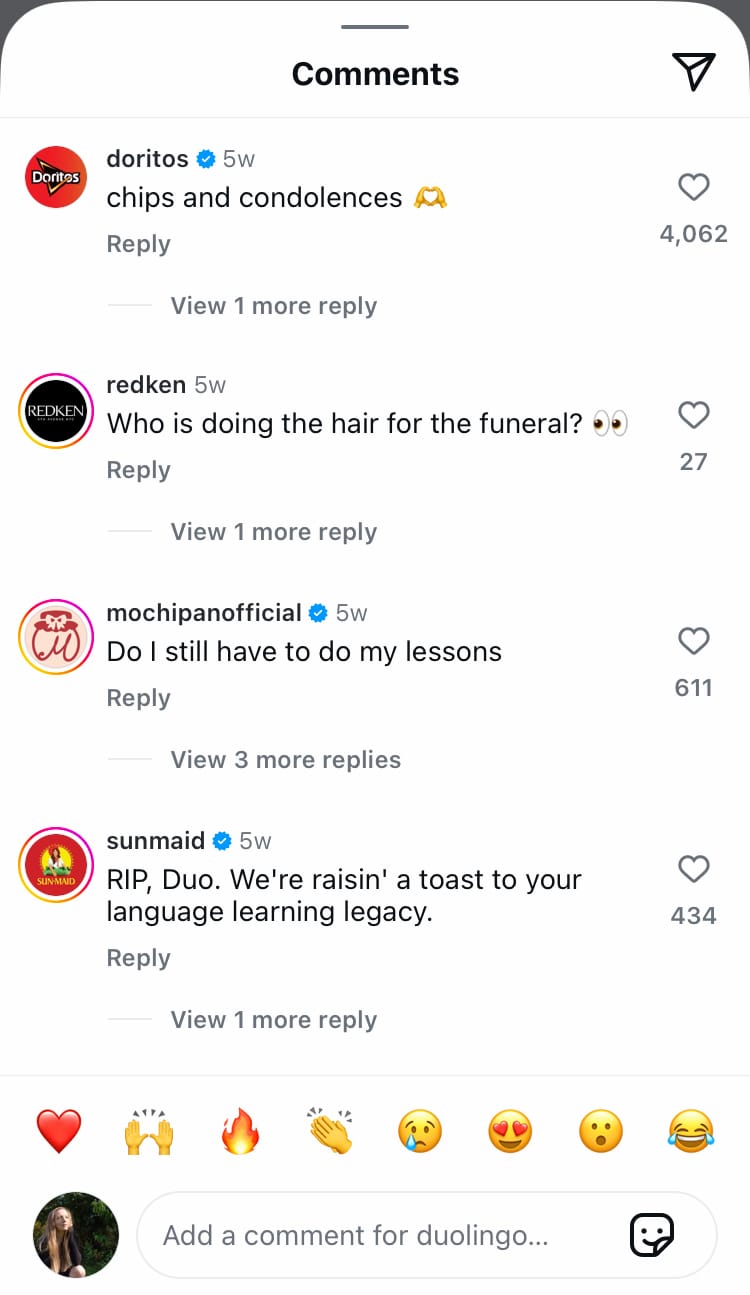
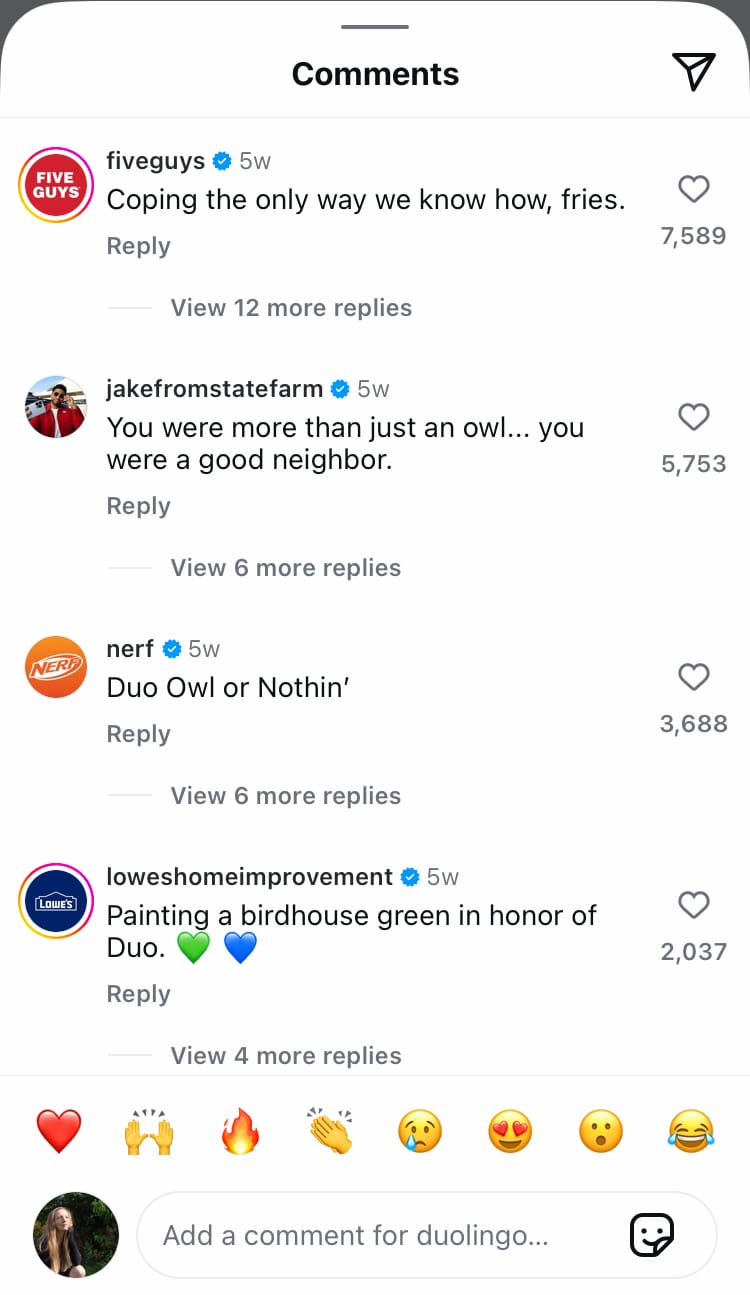
Comments by brands on Duolingo’s Instagram post
Trendjacking (also known as: socialjacking, trend hacking or social hacking) is a marketing technique that piggybacks off successful TV shows, games, celebrities and trends. One way brands do this is by creating parody-style content and plonking their brand at the centre of it. Duolingo is no stranger to trendjacking. It has released a host of high-performing content using this technique, so it seems fitting that trendjacking benefitted their own marketing campaign on this occasion.
During Duolingo’s marketing campaign, many brands latched onto the chatter to boost their own engagement, while giving a nod to the campaign starter. Below is a prime example, where Netflix inserted Duo into a clip of the award-winning show Squid Game.
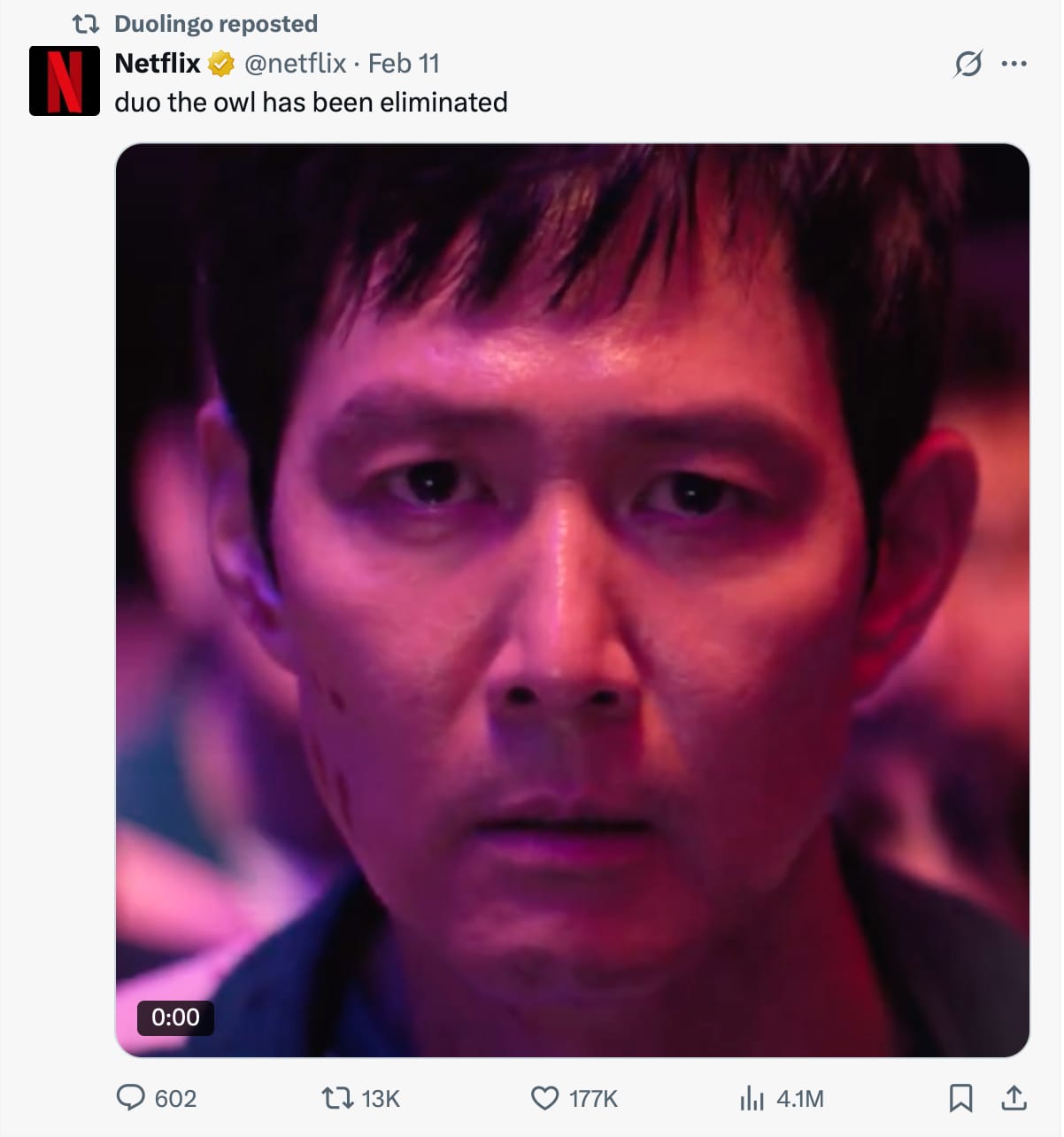

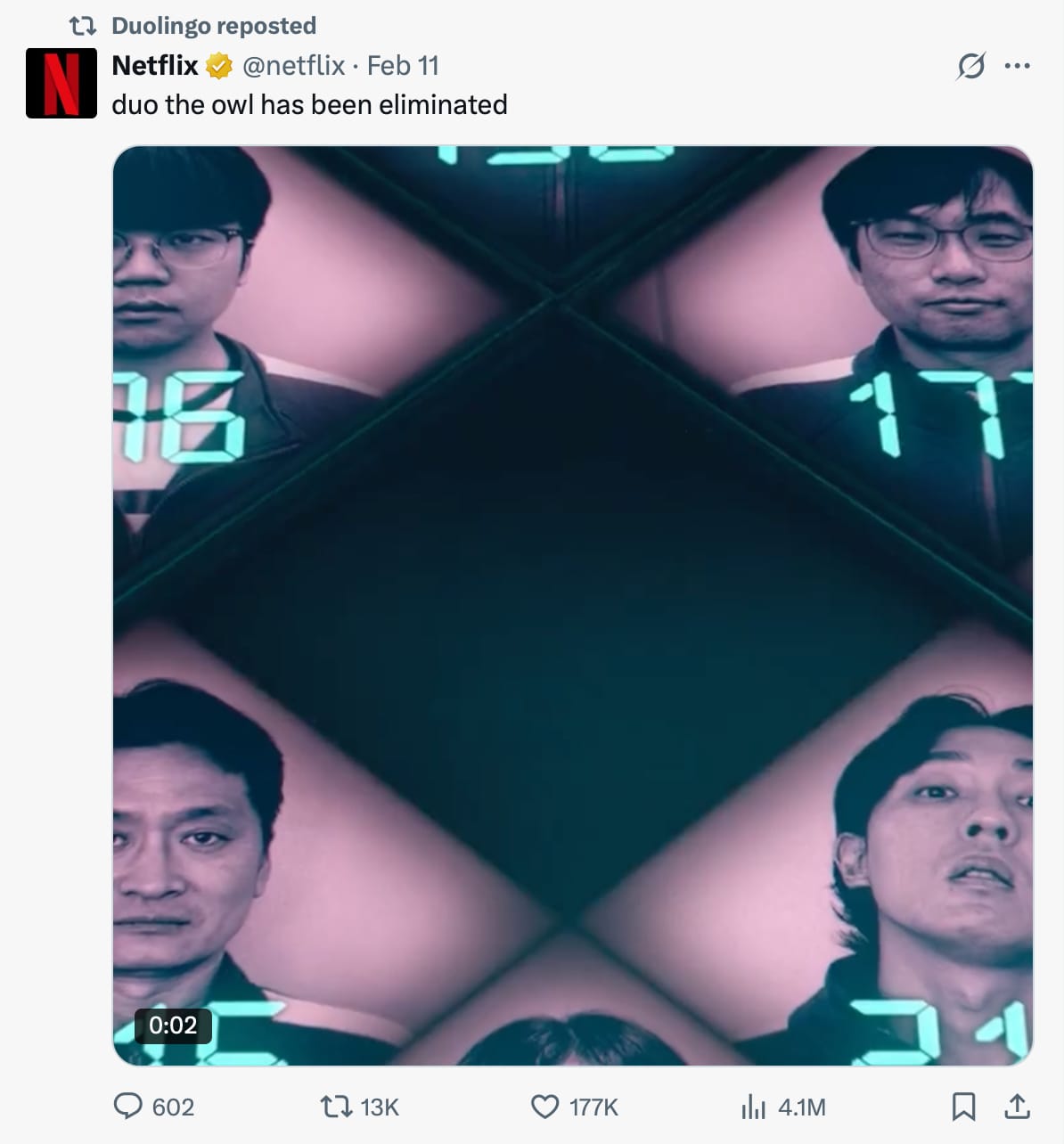
Other massive names that hopped into the conversation surrounding the campaign were X and the World Health Organization. When serious businesses break their usual routine to join in on a joke, it grabs attention in a truly unique way. Notice how Duolingo reposted the content, folding the attention back into the campaign and building hype in the process.
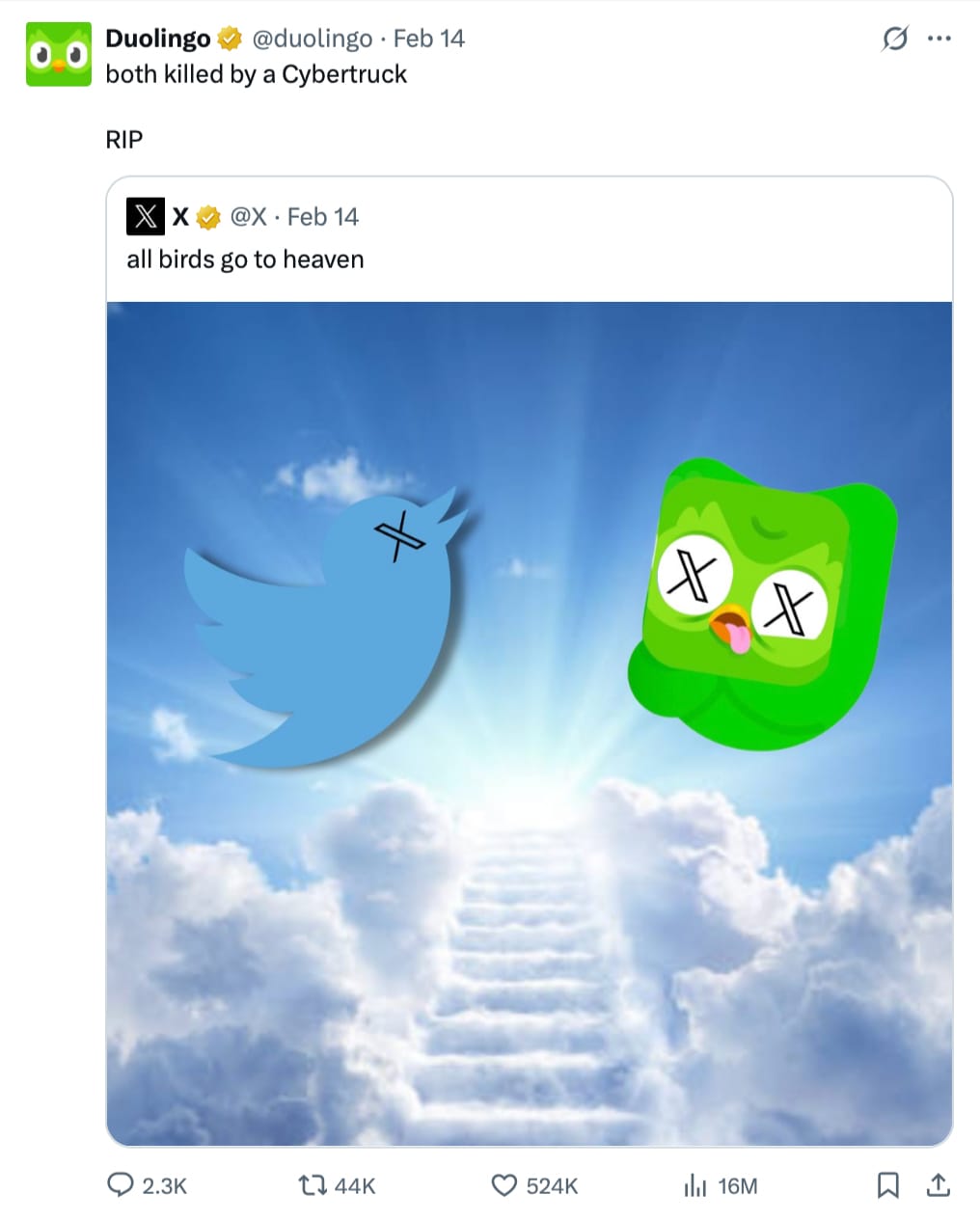
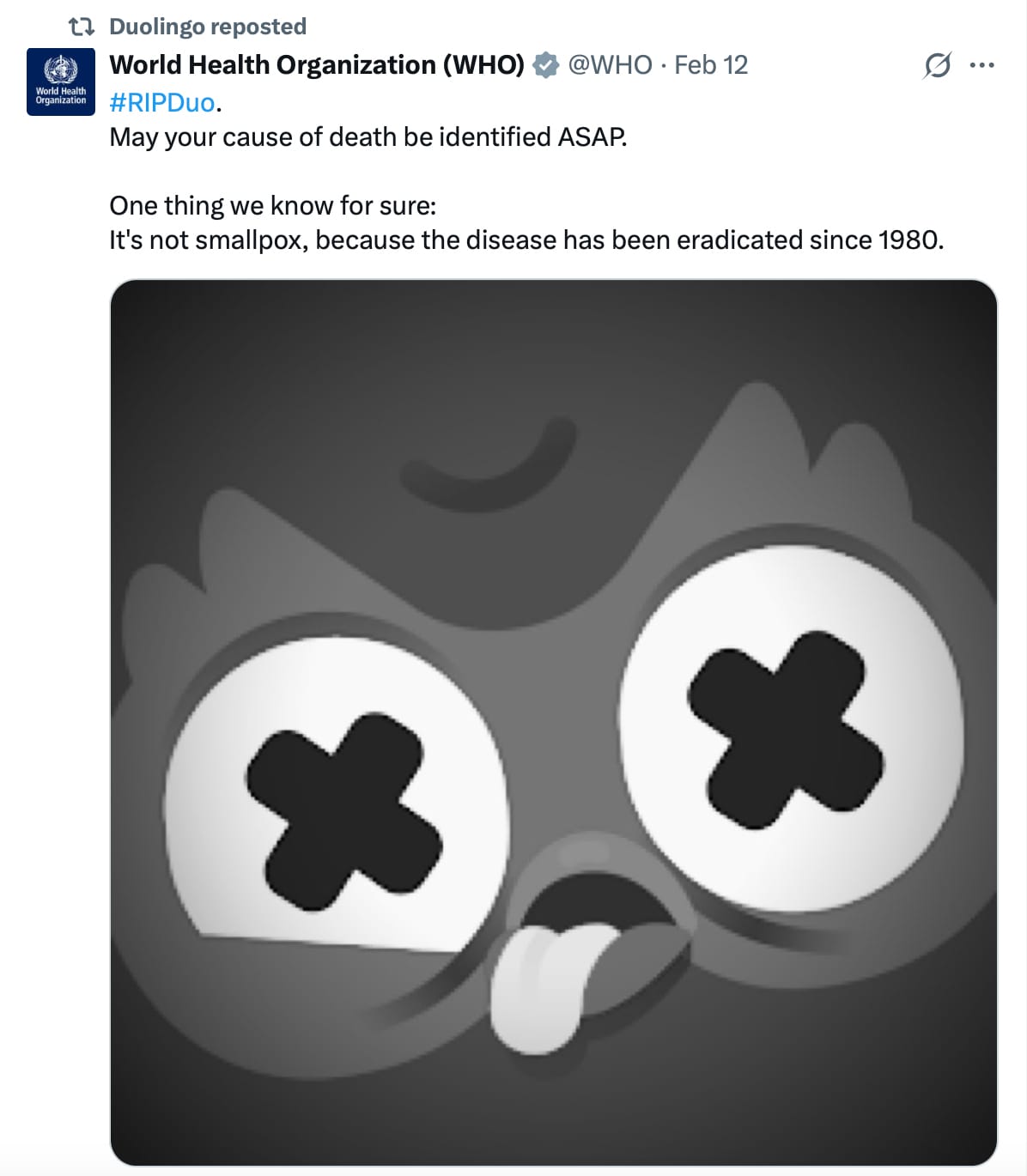
X post by X (left) and X post by the World Health Organization (right) reposted by Duolingo
It’s also worth noting that Duolingo has a long-running gag about Duo’s love for Dua Lipa, initially started because of their similar-sounding names. Dua Lipa was mentioned in the first post in the marketing campaign and the famous singer responded in a suitably fitting way.
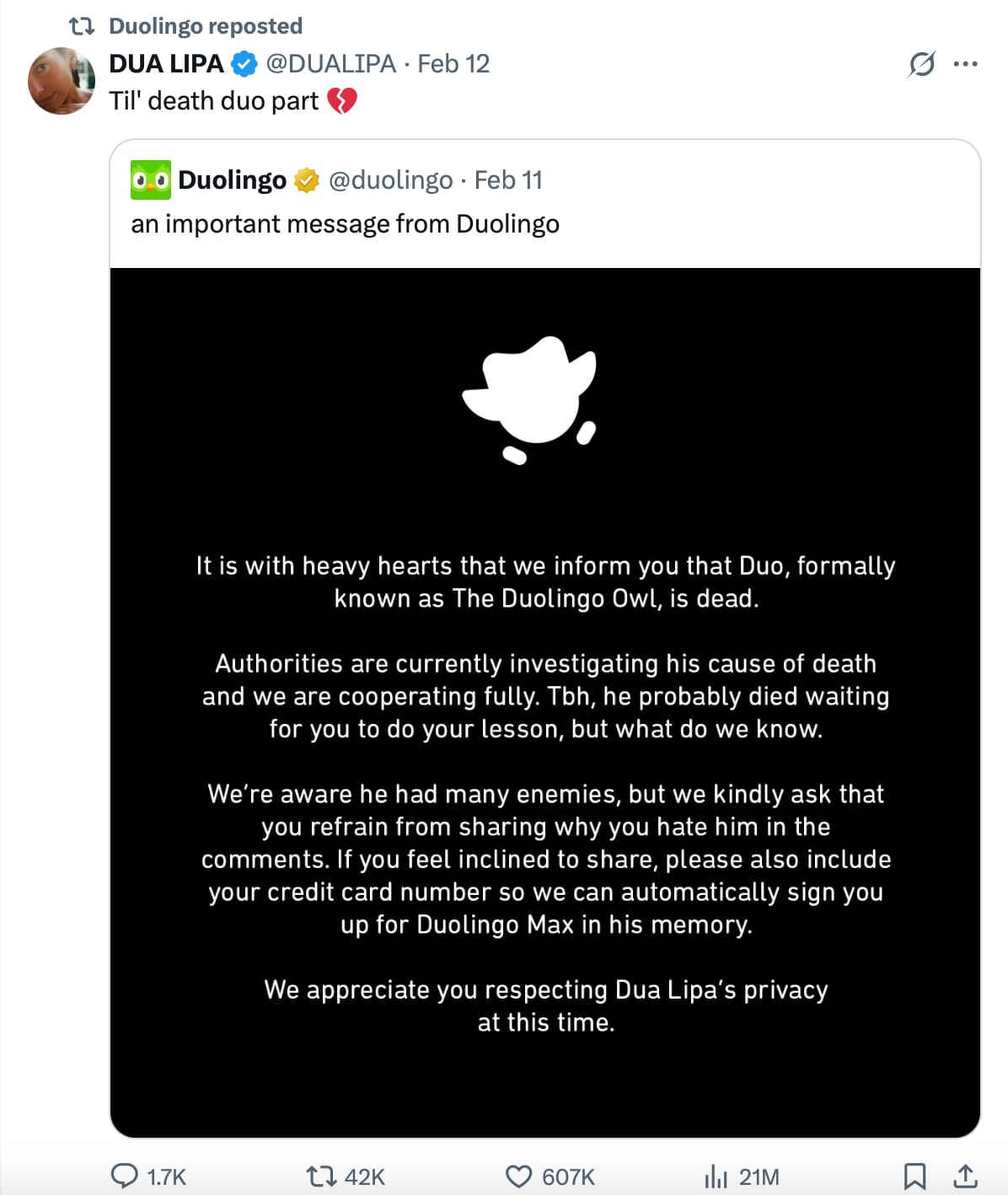
To top all this off, even more social proof was added to the mix when multiple news accounts ran with the story of Duo’s death. Pop Base’s X announcement got 21 million views.
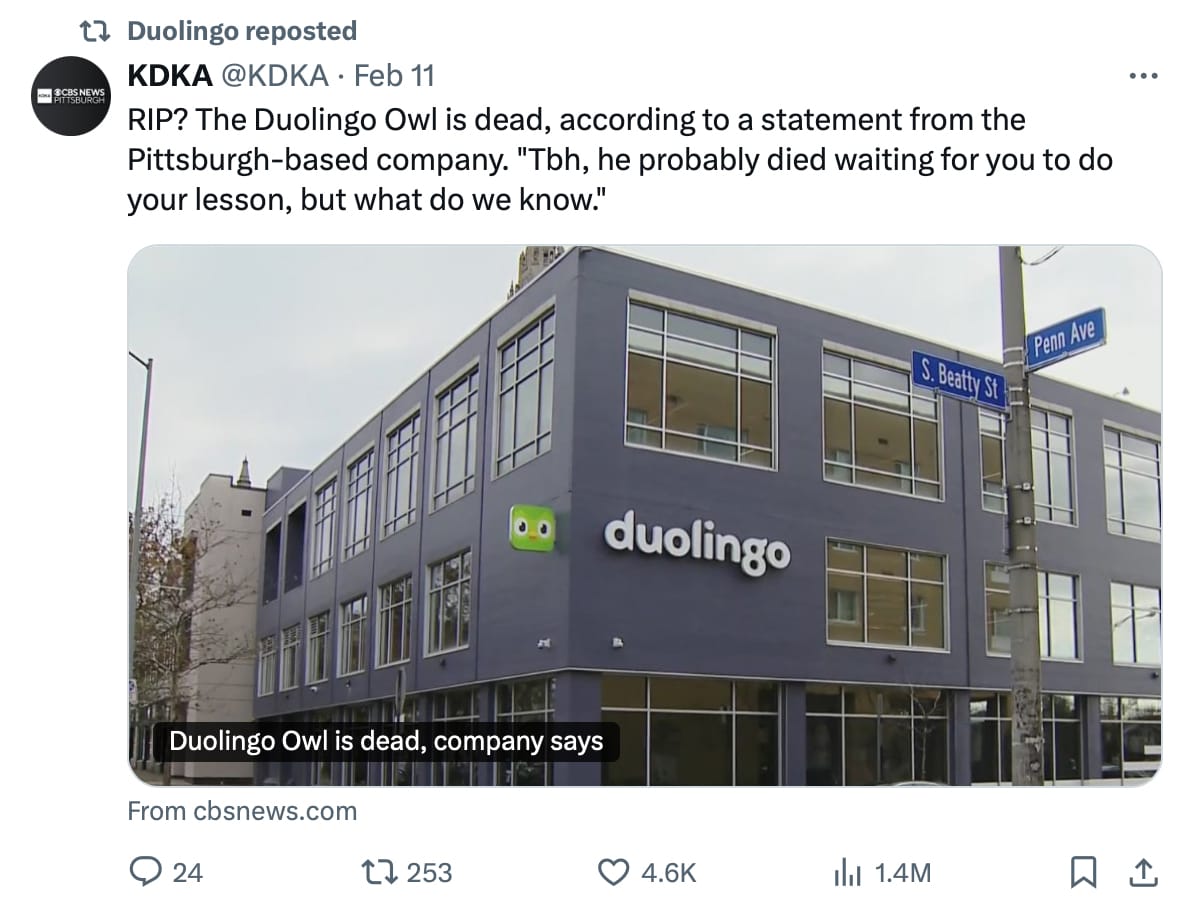
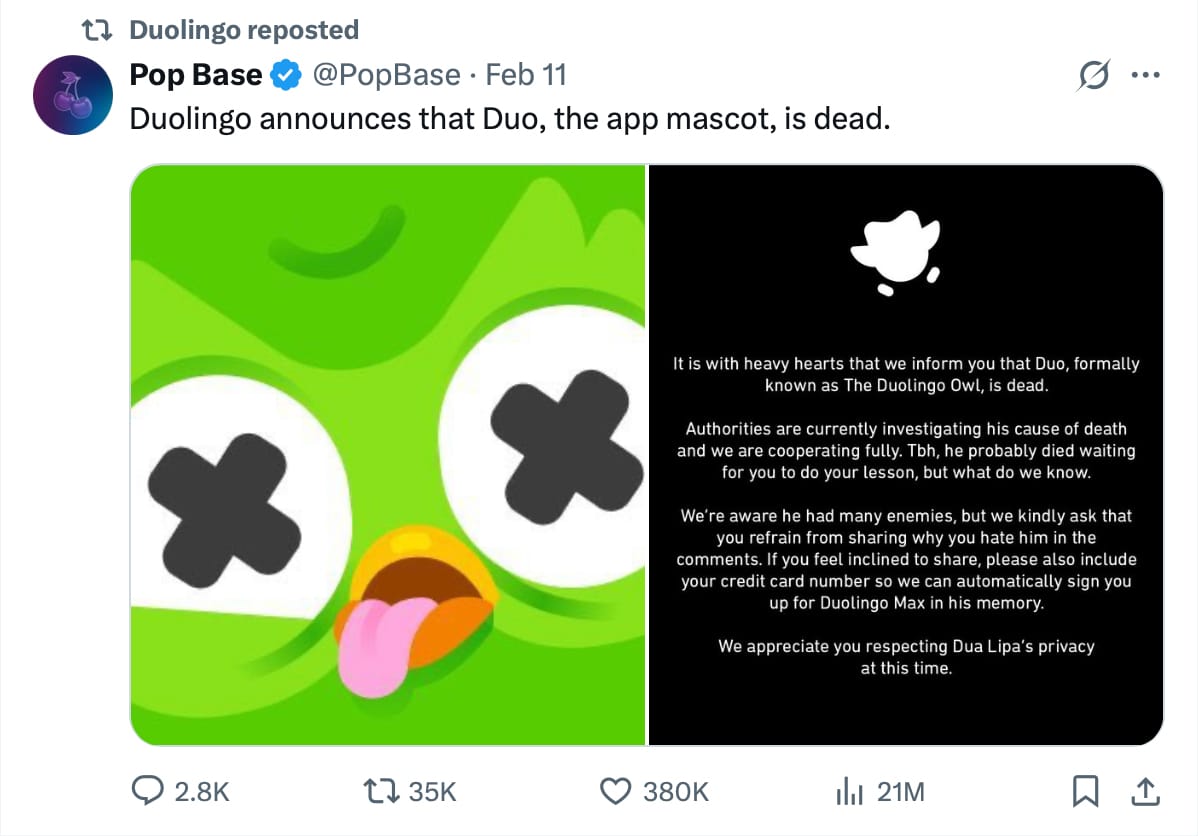
News posts on X by KDKA (left) and Pop Base (right) reposted by Duolingo
The sheer volume of high-status brands that joined in on the joke spread the marketing campaign far beyond the initial brand and its followers. This was a defining factor in making the campaign credible and contagious.
3. Committing to the bit
When you have an out-of-the-box idea, running with it is crucial to give it legs. Duolingo leveraged its personality and leaned far into the joke to make it work. It shared Duo’s other mascot friends carrying a coffin and invented a cause of death for Duo (complete with footage) which showed a Cybertruck knocking Duo down.
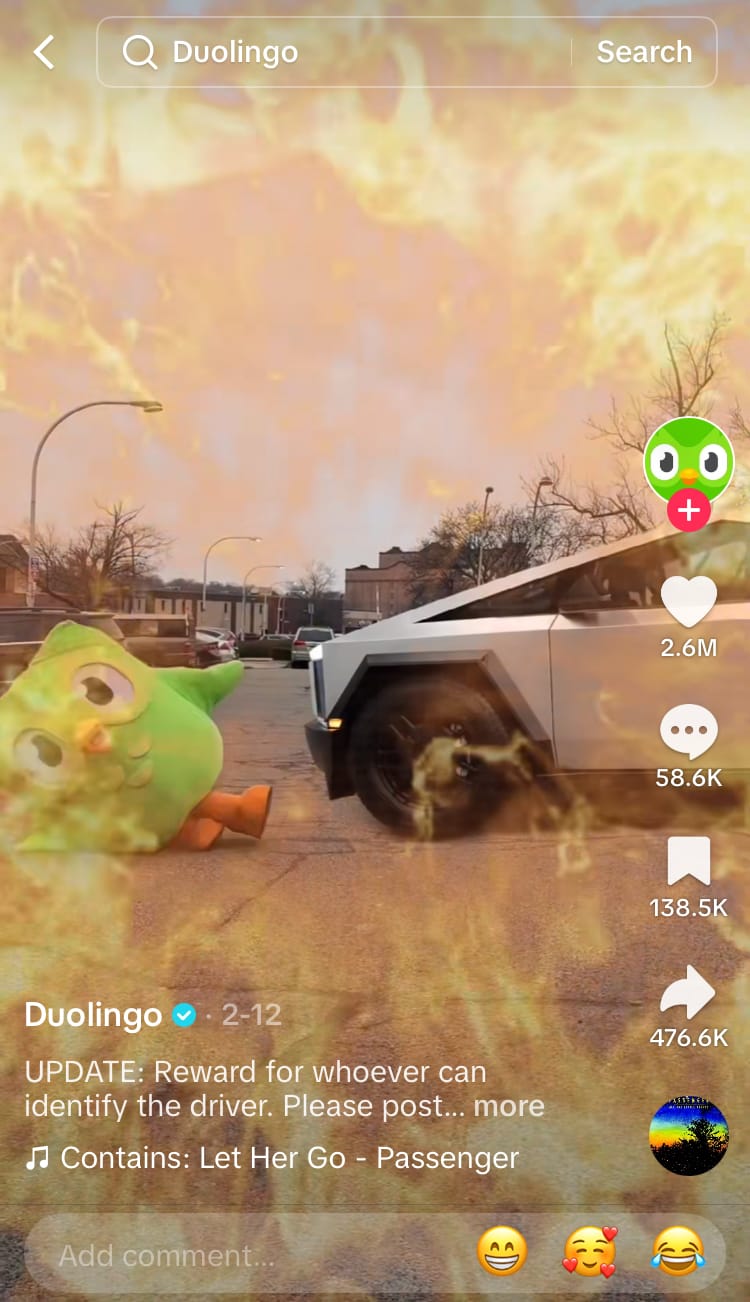
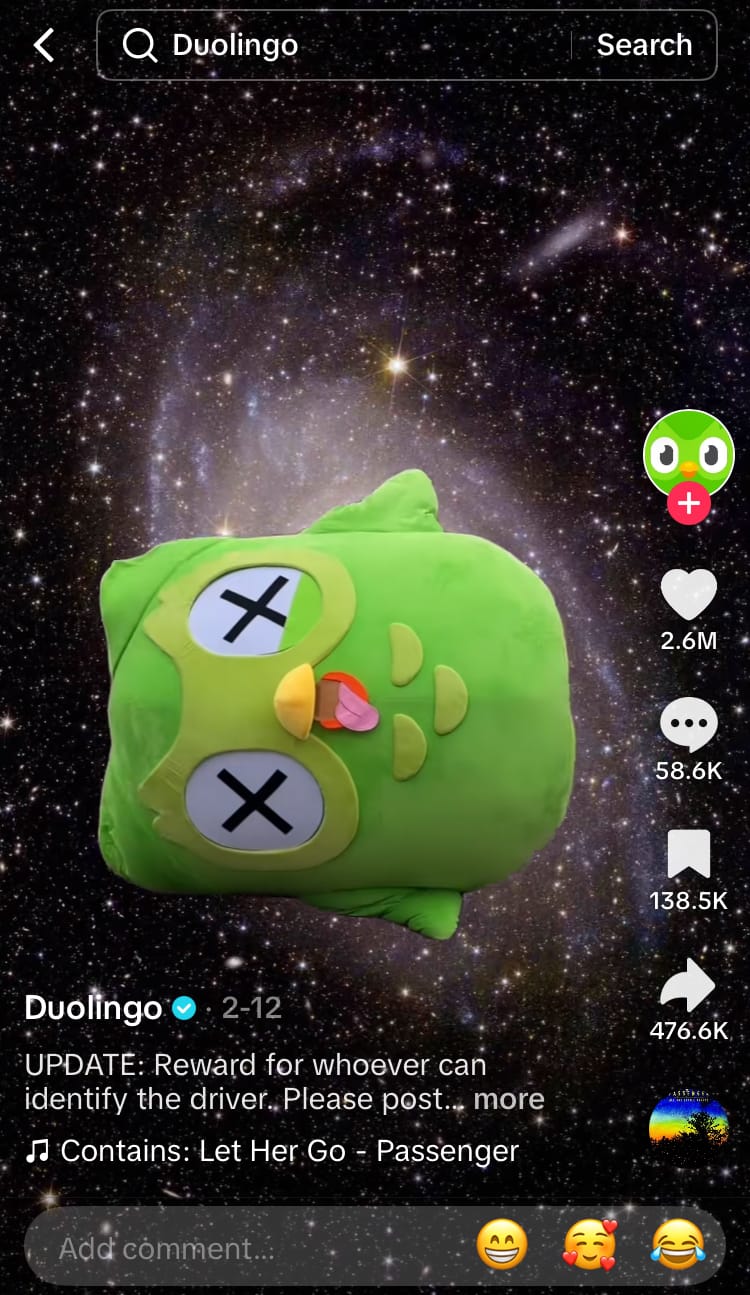
Duolingo then went a step further by killing off the rest of the recognisable characters featured on its app, with some wacky causes of death.
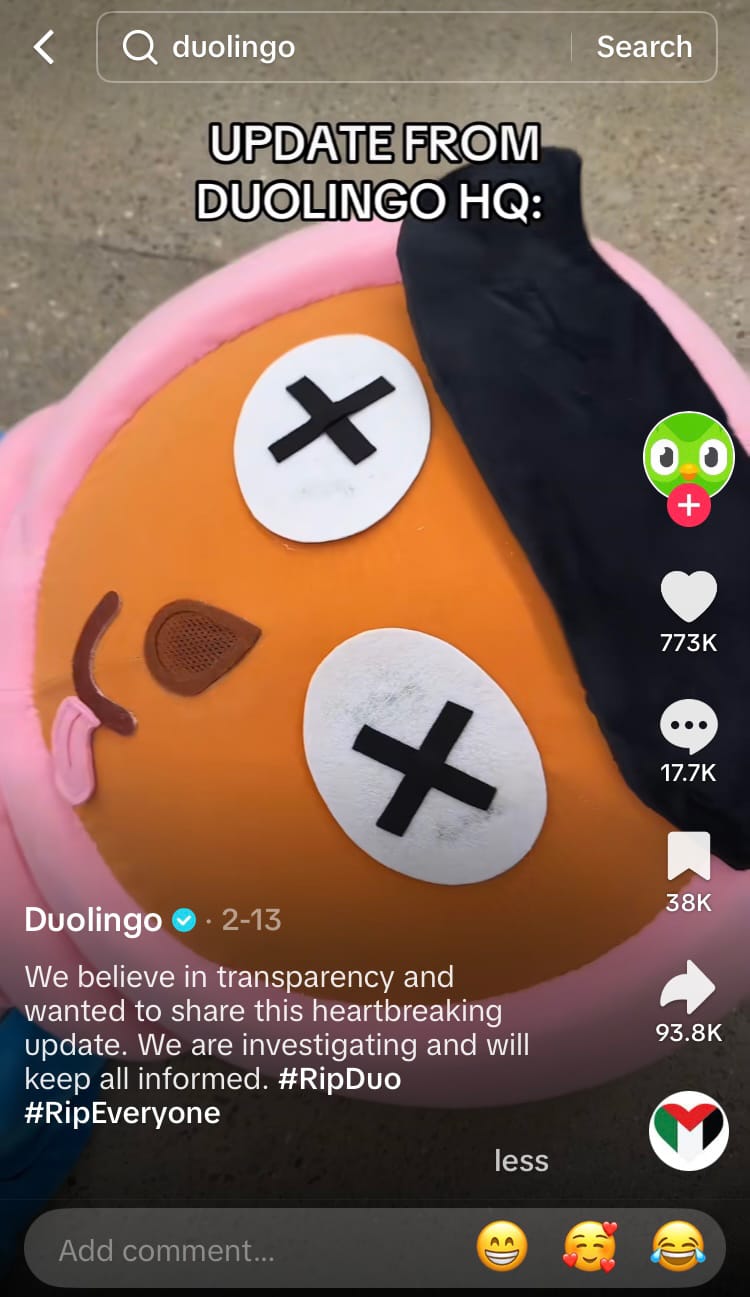
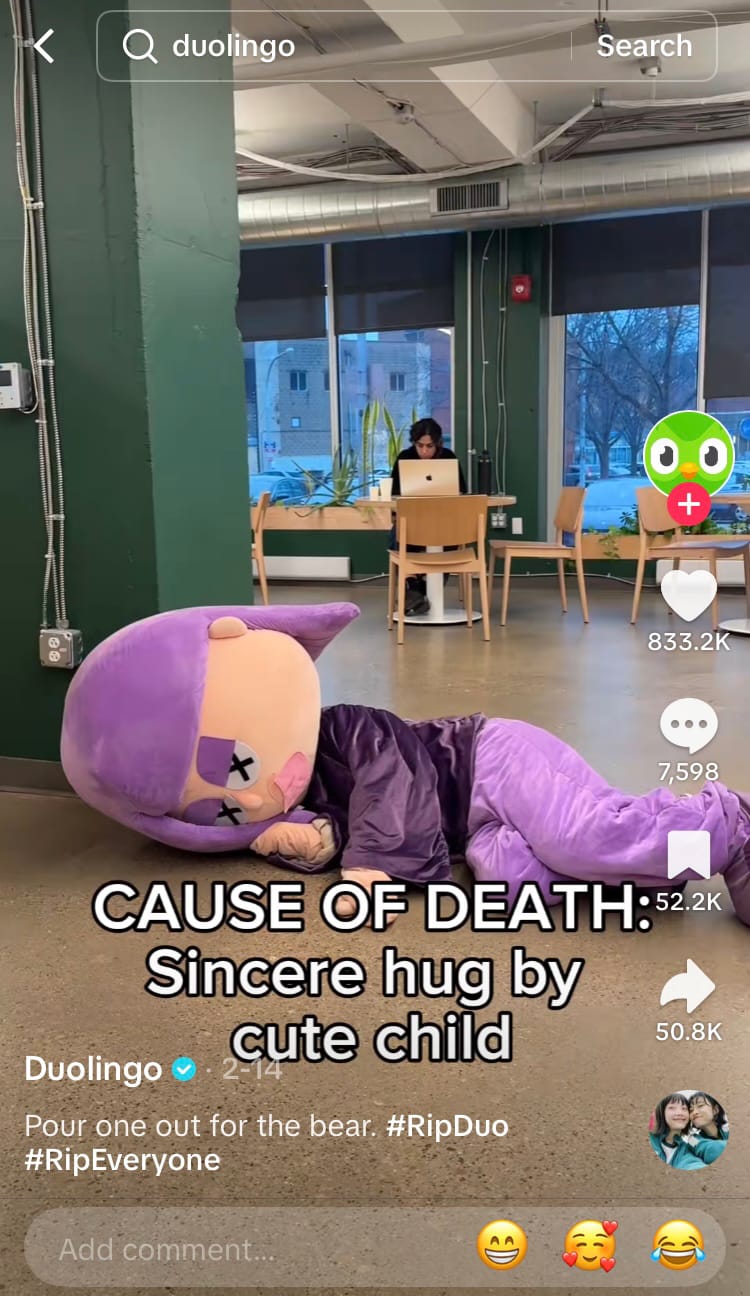
TikTok posts by Duolingo killing off mascots (left) and causes of deaths (right)
Duolingo’s social team later roped in the CEO Luis von Ahn, aka Duo’s Daddy, to give a speech about the situation. In the speech Luis von Ahn referenced Duo’s threatening notifications and encouraged users to do what Duo would have wanted - open the app and keep their learning streaks going.

By expanding on the initial idea in several follow-up pieces of content, Duolingo kept the conversation flowing and squeezed as much juice out of the idea as possible before its conclusion. Followers of the campaign were primed to have unanswered questions resolved in future content, as Duolingo kept everyone guessing as to where they were going with the storyline of the campaign. Equally, users seeing the brand for the first time were thrust into an entertaining, enjoyable, tongue-in-cheek tale with twists and turns and plenty of humour, making Duolingo a brand itching to be explored further.
Leaving the brand in a stronger position
Ultimately, a marketing campaign is designed and carried out to bring in new business and strengthen its community. A marketing campaign cannot be considered a success if it doesn’t achieve real growth for the business, whether that’s increasing brand awareness, trust or resulting in sales. Duolingo’s marketing campaign saw the brand’s social media followings increase without dipping after the campaign’s conclusion.
Within the marketing campaign, Duolingo used content to push its app and leverage more sales. Duolingo used the campaign to encourage people to use the app more and buy more plushies with the tongue-in-cheek addition of a limited edition coffin to encase its beloved characters.
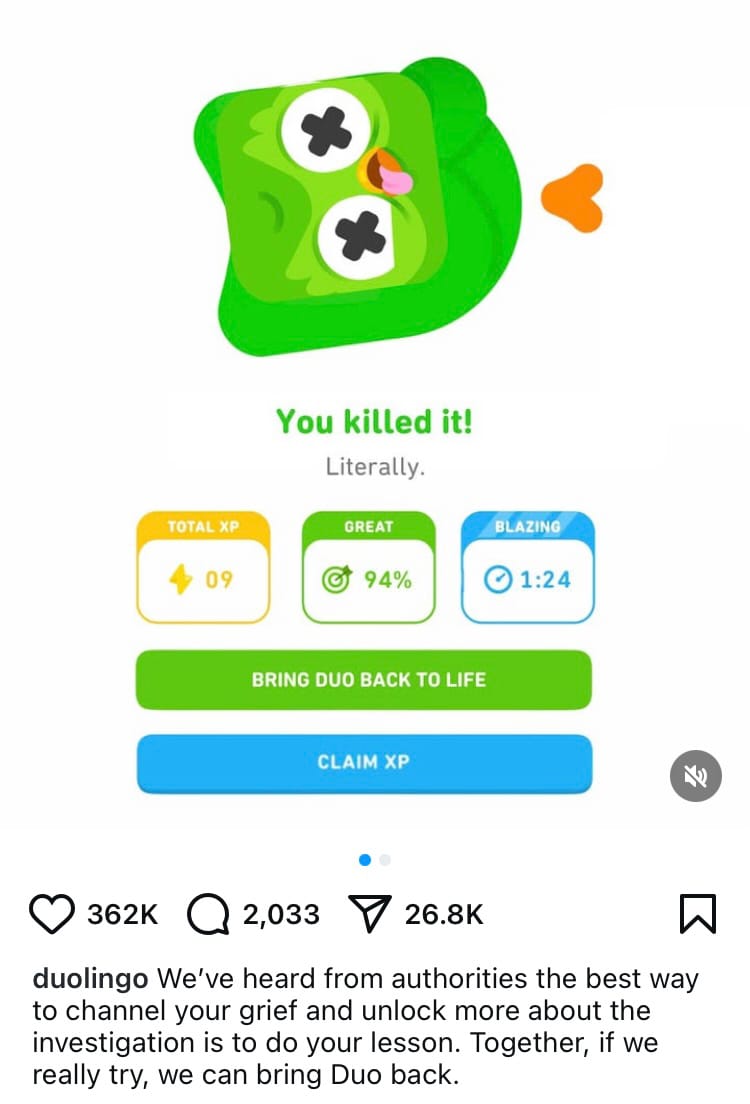
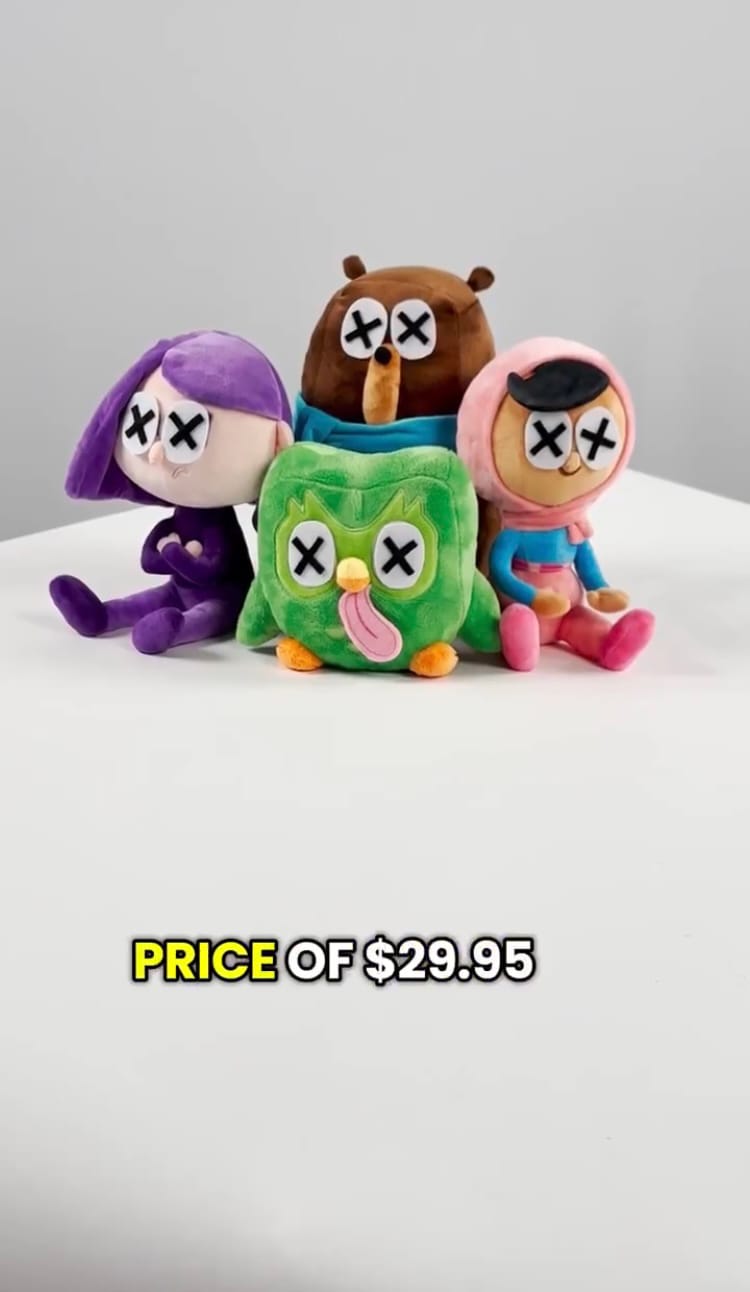
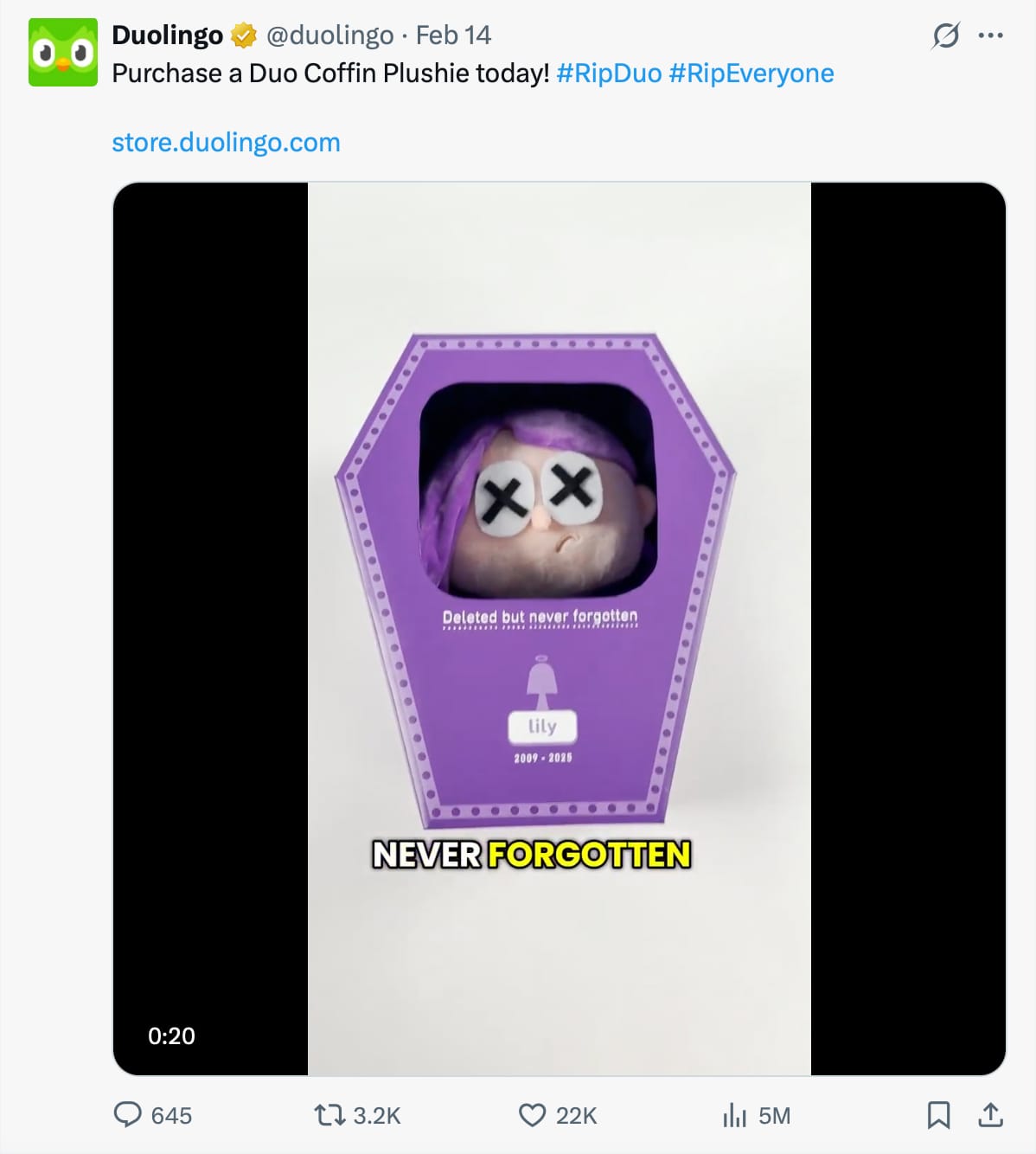
Instagram post (left) TikTok post (centre) and X post (right) by Duolingo
The revival of the Duo character showed the mascot coming back stronger; a sweet parallel to the brand continuing in an even stronger position than before. Duolingo’s campaign included several viral videos and Duolingo’s social lead Zaria Parvez has stated, “Whenever we have a viral video, we see an uptick in new users.” Therefore it’s reasonable to conclude that the campaign saw an increase in the app’s memberships - the ultimate aim of Duolingo’s marketing.

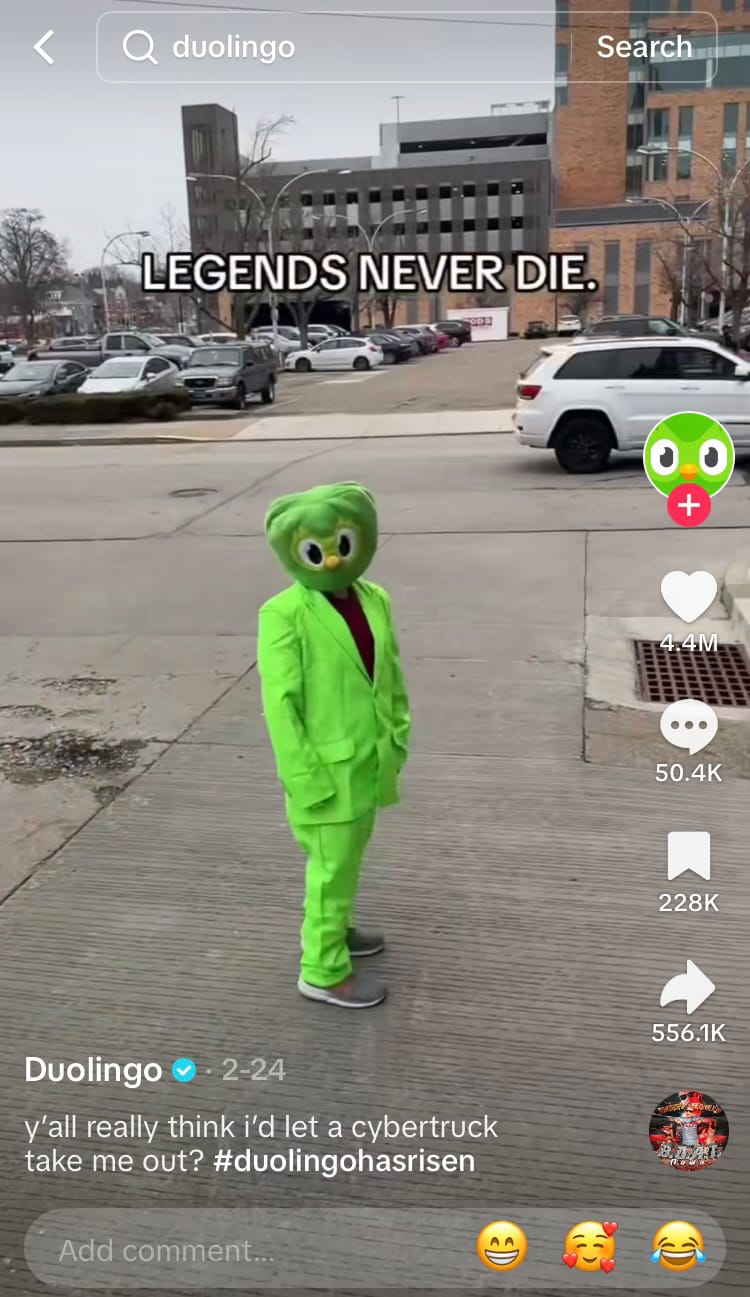
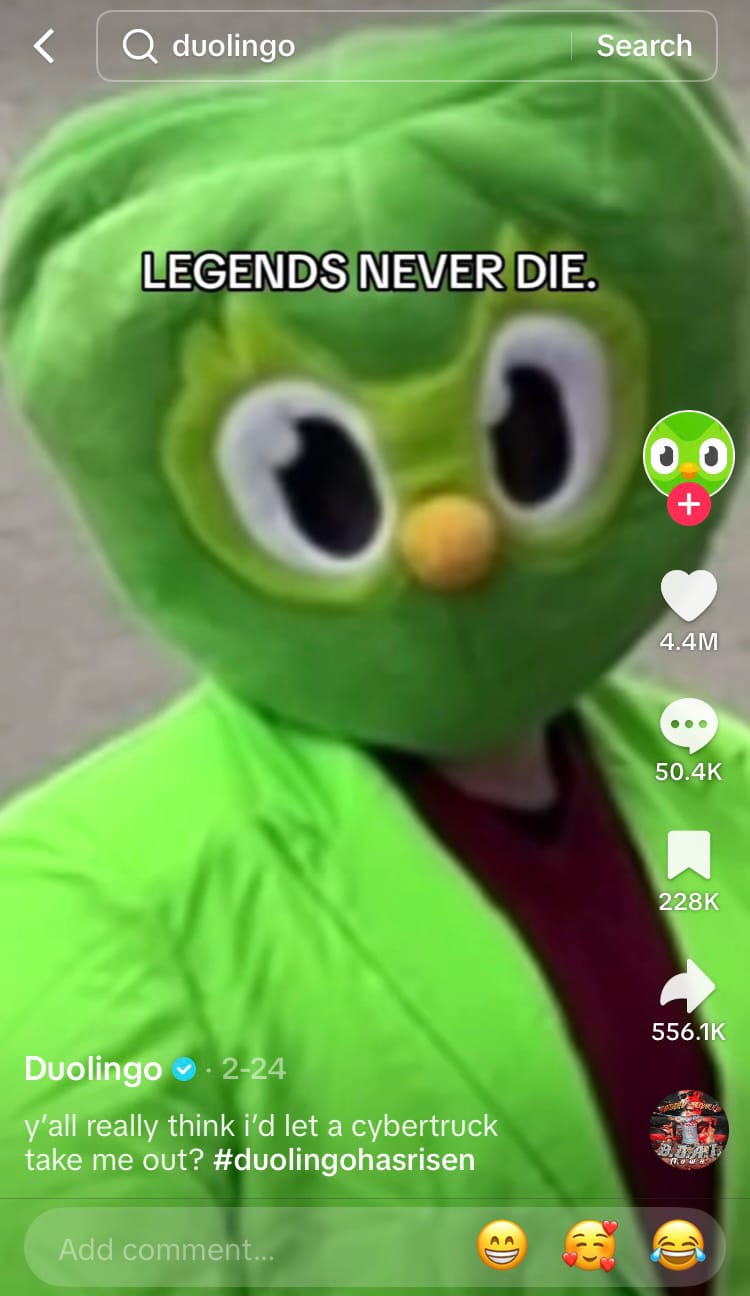
For your next marketing campaign, make sure you’re tracking all the important metrics to ensure it’s a success. With Minter.io you can get access to your unique social media analytics and your competitors’ metrics. You can even track specific hashtags, so you’ll have all the information to track, evaluate and report on your social media campaigns in one place. Check it out now.
Try Minter.io today →
